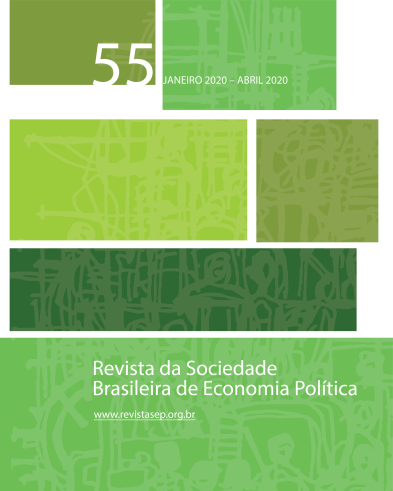Inflação e desemprego nos Estados Unidos da América durante a Grande Moderação
Uma interpretação pós-keynesiana crítica à do Novo Consenso
Palabras clave:
Economia Política, Grande Moderação, Inflação por conflito distributivoResumen
O presente artigo busca expor e interpretar o quadro macroeconômico observado nos Estados Unidos da América durante a Grande Moderação (especificamente a redução simultânea de inflação e desemprego observada entre as décadas de 1980 e 1990) a partir de uma abordagem pós-keynesiana, crítica à interpretação do Novo Consenso, na qual a redução do poder de barganha dos trabalhadores figura como elemento central na explicação deste desempenho macroeconômico.
Citas
BALL, L. & MANKIW, G. “The NAIRU in Theory and Practice”, The Journal of Economic Perspectives, vol. 16, no. 4, pp. 115-136, 2002.
BALL, L. & MOFFIT, R. “Productivity growth and the Phillips curve”, NBER Working Papers, n. 8421, 2001.
BARRO, R. J. & GORDON, D. “Rules, Discretion and Reputation in a Model of Monetary Policy”, Journal of Monetary Economics, n. 12, pp. 101-121, 1983.
BASTOS, C. P. M. Price Stabilization in Brazil - a critical review and a classical interpretation for an indexed nominal interest rate economy, 2002.
BERNANKE, B. The great moderation. Washington, DC: Eastern Economic Association, 2004.
BRAGA, J. Raiz unitária, histerese e inércia: a controvérsia sobre a NAIRU na economia norte americana nos anos 1990, 2006.
CESARATTO, S. & SERRANO, F. “As leis de rendimento nas teorias neoclássicas do crescimento: uma crítica sraffiana”, Revista Ensaios FEE, vol. 23, n. 2, 2002.
CLARIDA, R., GALÍ, J. & GERTLER, M. “The Science of Monetary Policy: A New Keynesian Perspective”, Journal of Economic Literature, vol. XXXVII, , pp. 1661-1707, December 1999.
FRIEDMAN, M. “The Role of Monetary Policy”, The American Economic Review, vol. 58, n. 1, pp. 1-17, 1968.
GLYN, A. Capitalism Unleashed. New York: Oxford University Press, 2006.
GOODFRIEND, M. “How the World Achieved Consensus on Monetary Policy”, Journal of Economic Perspectives, American Economic Association, vol. 21(4), pp. 47-68, 2007.
GOODFRIEND, M. & KING, R. “The New Neoclassical Synthesis and the Role of Monetary Policy” In: BERNANKE, Ben & ROTEMBERG, Julio (ed.). NBER Macroeconomics Annual 12. Cambridge: MIT Press, 1997, pp. 231-283.
GORDON, R. “The time-varying NAIRU and its implications for economic policy”, Journal of Economic Perspectives, Winter 1997.
GORDON, R. The History of the Phillips Curve: Consensus and Bifurcation. Northwestern University, NBER and CEPR, 2011.
KOTZ, D., MCDONOUGH, T. & REICH, M. Social structures of accumulation: the political economy of growth and crisis. Cambridge: Cambridge University Press, 1994.
KYDLAND, F. E. & PRESCOTT, E. C. “Rules Rather than Discretion: The Inconsistency of Optimal Plans”, Journal of Political Economy, n. 85, pp. 473-492, 1977.
LAVOIE, M. “A post-Keynesian amendment to the New consensus on monetary policy”, Metroeconomica, vol. 57, n. 2, pp. 165-192 , May, 2006.
LAVOIE, M. “Towards Taming the New Consensus: Hysteresis and Some Other Post-Keynesian Amendments” In: FONTANA, Giuseppe & SETTERFIELD, Mark (ed.). Macroeconomics and Macroeconomic Pedagogy. Basingstoke: Palgrave Macmillan, 2008, pp. 191-213.
LAVOIE, M. Post-Keynesian economics: new foundations. Cheltenham, UK: Edward Elgar Publishing, 2014.
PALLEY, T. “The economics of the Phillips curve: Formation of inflation expectations versus incorporation of inflation expectations”, Structural Change and Economic Dynamics, 23 (3), pp. 221-230, 2012.
PALUMBO, A. Demand and supply forces vs institutions in the interpretations of the Phillips curve, mimeo, Dipartamento di Economia, Roma Tre, 2008.
POLLIN, R. Wage bargaining and the US Phillips Curve: was Greenspan right about traumatized workers in the 90s?. Amherst: Political Economy Research Institute, University of Massachusetts, 2002.
ROMER, C. & ROMER, D. The Evolution of Economic Understanding and Postwar Stabilization Policy. Rethinking Stabilization Policy. Federal Reserve Bank of Kansas City, pp. 11-78, 2002.
SELLON, H. et alii. “New challenges for monetary policy: a summary of the Bank's 1999 Symposium”, Economic Review-Federal Reserve Bank of Kansas City, vol. 84, n. 4, pp. 5-16, 1999.
SERRANO, F. “Relações de poder e a política macroeconômica americana, de Bretton Woods ao Padrão Dólar Flexível” In: FIORI, José Luís (org.). O poder americano. Petrópolis: Vozes, 2004, pp. 190-224.
SERRANO, F. Mind the gap: hysteresis, inflation dynamics and the Sraffian supermultiplier. IE-UFRJ, 2006.
SERRANO, F. “O conflito distributivo e a teoria da inflação inercial”, Revista de Economia Contemporânea, 2010.
SERRANO, F. & BRAGA, J. “O mito da contração fiscal expansionista nos EUA durante o governo Clinton”, Economia e Sociedade, vol. 15, n. 2 (27), pp. 213-239, Campinas, agosto 2006.
SETTERFIELD, M. “Worker Insecurity and U.S. Macroeconomic Performance During the 1990s”, Review of Radical Political Economics, vol. 37, n. 2, pp. 155-177, 2005.
SETTERFIELD, M. “Balancing the macroeconomic books on the backs of workers: a simple Analytical Political Economy model of contemporary US capitalism”, International Journal of Political Economy, n. 35, pp. 46-63, 2006.
SNOWDON, B. & VANE, H. Modern macroeconomics: its origins, development and current state. Cheltenham, UK: Edward Elgar, 2005.
STIRATI, A. “Inflation, Unemployment and Hysteresis: an alternative view”, Review of Political Economy, vol. 13, n. 4, 2001.
STOCK, J. & WATSON, M. “Has the business cycle changed and why?” In: NBER Macroeconomics Annual 2002, vol. 17, MIT press, 2003, pp. 159-230.
SUMMA, R. Um modelo alternativo ao "Novo Consenso" para economia aberta, Rio de Janeiro, 2010.
TAYLOR, J. “Is there a core of usable macroeconomics we should all believe in?”, American Economic Review, n. 87, pp. 230–232, 1997.
TAYLOR, J. “Teaching modern macroeconomics at the principles level”, American Economic Review, 90(2), pp. 90-94, 2000.




